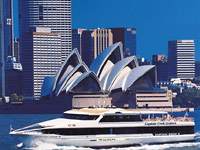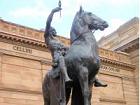INFO on Australian
 Sydney
Sydney
Sydney, the capital of the Australian State of New South Wales is Australia's oldest and largest city with a population of almost 4 million, and covering almost 1120 square kilometres (700 square miles). Sydney is a safe, fresh, friendly destination with a warm, sunny climate that makes a visit perfect in any season. In fact, at least 240 days of sunshine a year means your visit will be as bright as the sparkling, ever-visible harbour.
Sydney is one of the great seaports of the world. It is also the nation's most popular tourist destination.
The city is divided into North and South by the Sydney Harbour, with both Sydney Harbour Bridge and Tunnel connecting them. Most of the tourist attractions are in the South part of the city, with a large business and residential area in the North.
The South part of the city consists of The Rocks and Circular Quay to the North, with the Central Station marking the South. Darling Harbour marks the West and there are a number of parks to the East.
Sydney has many influences upon its style. Aboriginal sites and engravings can still be seen from the original occupiers, the Eora tribe. The city also has an anglo-mediterranean style and a growing Chinese and Asian influence.
Sydney is a remarkably easy city to move around in. An excellent train, bus and ferry service covers all points of the greater metropolitan area. Roadways, although congested in peak hour times, are generally well planned and driving is not too harrowing an experience.
Most Sydney tourist attractions are either within the central business district, close to the CBD, or at points around the harbour. The exceptions are Bondi and Manly - surf beach suburbs situated south and north of Sydney Heads.
Book online
 Attractions
Attractions
Opera House
The Opera House is acclaimed as the most outstanding building of the 20th century
The Sydney Opera House is on Circular Quay. It was completed in 1973 and was designed by Joern Utzon. The first public performance being Prokofiev's 'War and Peace', and the acoustics are fabulous. From outside the Sydney Opera House looks remarkable and if you get up close you will be able to see several of the million or so ceramic tiles which cover the Sydney Opera House shells.
The Opera House hosts 4 auditoriums, showing music, ballet, theatre and film performances. The Studio is a new venue, which offers contemporary performances. Sunday generally offers the cheapest tickets, although there are a range of prices offered all weekend as well as several free performances.
 The box office is open:
The box office is open:
Monday - Saturday
9.00am - 8.30pm
Sunday
2 1/2 hours before the performance
Darling Harbour
Darling Harbour is intended to be one of Sydney's "buzz" places, although some visitors find it lacking in character (and greenery). A former dockside area, the small harbour has been transformed into a major tourist site and leading convention and exhibition centre. A monorail service runs from the Central Business District to Darling Harbour and skirts the harbour, making stops at points around the harbour. Until now, Darling Harbour has been a place that has appealed more to little folk, due to the number of children's attractions, but the advent of the Cockle Wharf restaurant and cafe complex has added a new dimension to Darling Harbour.
 Beaches
Beaches
Sydney is paradise for beach lovers. Within the metropolitan area there are more than 30 ocean beaches, all with golden sand and rolling surf, as well as several more around the harbor with calmer water for safe swimming. (Bondi, Coogee, Manly )
Harbour Bridge
The bridge is the largest steel arch bridge in the world being 134 metres high, 49 metres wide with a curve of 503 metres. The bridge has six million rivets in total, and weighs 52,800 tonnes. It stretches from Dawes Point on one side of the Sydney Harbour to Milsons Point on the other.
It is definitely worth climbing the Sydney Harbour Bridge, which starts from within a stone pylon at one end, then travels along the top of the structure, where there are spectacular views
Zoo
The wildlife at Sydney's world-class Taronga Zoo, perched high above the harbour, also enjoy fabulous vistas. A spectacular cable car ride from the fern/ wharf leads to exhibits showcasing Australia's unique wildlife, including kangaroos, cuddly koalas, emus, wombats and kookaburras, as well as the world's most exotic animals.

Chinese Garden of Friendship
The Chinese Garden of Friendship is nestled at the south end of Darling harbour and a short walk from Chinatown. Entering the gardens is like walking backwards in time into the quiet solitude of ancient Chinese architecture and it's relationship with nature. The garden combines the elements of water, plants, stone and architecture.
National Parks
Sydney offers a number of wonderful National Parks surrounding the attractive city. The Sydney Harbour National Park is made up of several islands and bushland around the harbour.
It offers Aboriginal carvings, history, views and walks. The areas included as part of the National Park are Ashton Park, Dobroyd Head, Fort Denison, Goat Clarke, Middle Head, Nielsen Park, North Head, Rodd Island, Shark Island and South Head.
Kings Cross
Kings Cross is also home to one of Sydneys oldest areas, Wooloomooloo. Here, opposite the Artspace Gallery, you will find Harry's Cafe de Wheels, open for 18 hours a day, started in 1945. It is a must visit on the way home after a night out.
A couple of interesting places to visit near Kings Cross, include Elizabeth House and the Sydney Jewish Museum. Elizabeth House is a Greek Revival style building which is magnificent, and theer are great views from the top of the building. Sydney Jewish Museum tells the hostory of Jews within Australia and has some good exhibitions.

The Sydney Fish Market
The Sydney Fish Market is the major fish market of Australia, with the largest and most diverse range of seafood to offer. The Market has over 100 different species, both proverbial and exotic to please customers from all different cultures and culinary preferences. The produce comes from both national and international waters. This fish market, with regard to diversity and quality, is the largest of its kind in the world behind the markets of Japan. The Market deals with over 15 million tonnes of seafood each year on the foreshore of Sydney Harbour
Oxford Street
Oxford Street offers great nightlife. It is packed with bars, cafes, nightclubs, shops and cinemas. The main part of it runs from Hyde Park to Centennial Park, and is based around Taylor Square, although the street continues to Bondi Junction. Bus numbers 380 and 382 travel from Circular Quay all along Oxford Street, which you can catch.
 When to Go
When to Go
Australia is in the Southern Hemisphere, so the seasons are reversed. It's winter Down Under during the American and European summer.
The best times to visit Sydney are during late spring and early fall. The spring months of October and November are pleasantly warm, although the ocean is slightly cool for swimming. The midsummer months of December through February are typically hot and humid, with the likelihood of fierce tropical downpours in January and February. In the early autumn months of March and April, weather is typically stable and comfortable, outdoor city life is still in full swing, and the ocean is at its warmest. Even the coolest winter months of July and August typically stay mild and sunny, with average daily maximum temperatures in the low 60s.
Transportation
Airport
The Kingsford Smith Airport is the main international and domestic airport.
 These are open daily from about 5 AM-10 PM or later, depending on flight arrival or departure times.
These are open daily from about 5 AM-10 PM or later, depending on flight arrival or departure times.
Flying times are as follows: from New York to Sydney (via Los Angeles), about 21 hours; from Chicago to Sydney (via Los Angeles), about 19 hours; from Los Angeles to Sydney (nonstop), about 14 hours; and from London to Sydney, about 20½ hours via Singapore or Bangkok.
Monorail & Tram
Sydney Monorail is one of the fastest, most relaxing forms of public transport in the city, but its use is limited to travel between the city center, Darling Harbour, and Chinatown.
Rail
The Sydney Light Rail, identifiable by signs with a large black "M" against a white background, is a limited system that provides a fast, efficient link between Central Station, Darling Harbour, the Star City casino and entertainment complex, Sydney fish markets, and the inner-western suburbs of Glebe and Lilyfield. The modern, air-conditioned tram cars operate at 5- to 11-minute intervals, 24 hours a day.

Ferries
Taking a City Circle train, the Monorail or walking is the best way of seeing city attractions.
Sydney Ferries, which are also government run, provide an inexpensive way of seeing the most beautiful harbour in the world.
Train
The main terminal for long-distance and intercity trains is Central Station (Eddy Ave., City South.), about 2 km (1 mi) south of the city center.
For journeys in excess of 7 km (4 mi), Sydney's trains are considerably faster than buses. However, the rail network has been designed primarily for rapid transit between outlying suburbs and the city. Apart from the City Circle line, which includes the Circular Quay and Town Hall stations and the spur line to Kings Cross and Bondi Junction, the system does not serve areas of particular interest to tourists. If you plan on using the trains, remember the following axioms: all trains pass through Central Station; Town Hall is the "shoppers" station; the bus, ferry, and train systems converge at Circular Quay. Trains generally operate from 4:30 AM to midnight.
Book online
 Climate
Climate
For Sydney climate and monthly mean temperature, rainfall and sunshine information
Sydney enjoys a temperate climate with a mild winter, and has more than 340 sunny days a year. Average minimum temperatures in the winter months of June through to August is around 9 degrees Celsius (47-48 degrees Farenheit). The summer season is from December through to February
The following are the normal daily temperature ranges for Sydney:
January 65-79°F (18-26°C); February 65-79°F (18-26°C); March 63-76°F (17-24°C); April 58-72°F (14-22°C); May 52-67°F (11-19°C); June 49-61°F (9-16°C); July 49-61°F (9-16°C); August 49-63°F (9-17°C); September 52-67°F (11-17°C); October 56-72°F (13-22°C); November 61-74°F (16-23°C); December 63-77°F (17-25°C).
Sydne Map
INFO on Australian

 Sydney
Sydney Attractions
Attractions The box office is open:
The box office is open:
 Beaches
Beaches 

 When to Go
When to Go  These are open daily from about 5 AM-10 PM or later, depending on flight arrival or departure times.
These are open daily from about 5 AM-10 PM or later, depending on flight arrival or departure times.

 Climate
Climate





